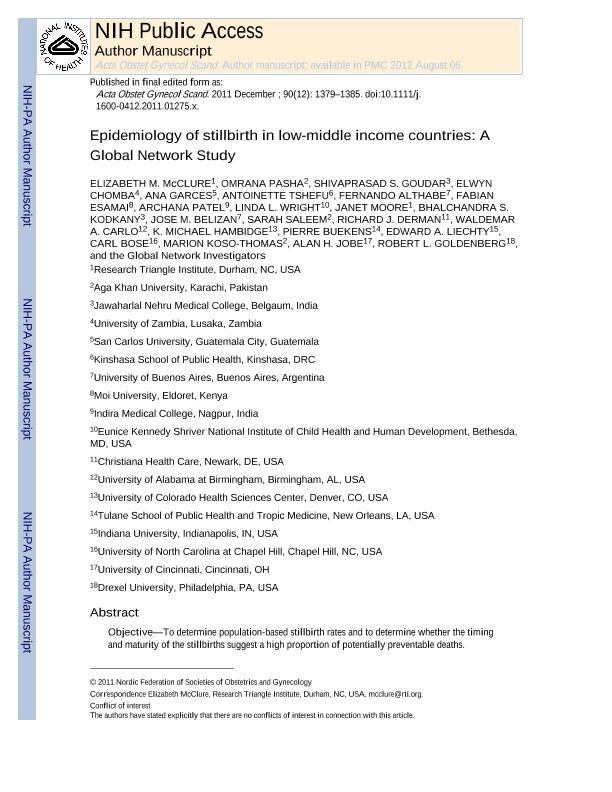Artículo
Epidemiology of stillbirth in low-middle income countries: A Global Network Study
McClure, Elizabeth M.; Pasha, Omrana; Goudar, Shivaprasad S.; Chomba, Elwyn; Garces, Ana; Tshefu, Antoinette; Althabe, Fernando ; Esamai, Fabian; Patel, Archana; Wright, Linda L.; Moore, Janet; Kodkany, Bhalchandra S.; Belizan, Jose
; Esamai, Fabian; Patel, Archana; Wright, Linda L.; Moore, Janet; Kodkany, Bhalchandra S.; Belizan, Jose ; Saleem, Sarah; Derman, Richard J.; Carlo, Waldemar A.; Hambidge, K. Michael; Buekens, Pierre; Liechty, Edward A.; Bose, Carl; Koso Thomas, Marion; Jobe, Alan H.; Goldenberg, Robert L.
; Saleem, Sarah; Derman, Richard J.; Carlo, Waldemar A.; Hambidge, K. Michael; Buekens, Pierre; Liechty, Edward A.; Bose, Carl; Koso Thomas, Marion; Jobe, Alan H.; Goldenberg, Robert L.
 ; Esamai, Fabian; Patel, Archana; Wright, Linda L.; Moore, Janet; Kodkany, Bhalchandra S.; Belizan, Jose
; Esamai, Fabian; Patel, Archana; Wright, Linda L.; Moore, Janet; Kodkany, Bhalchandra S.; Belizan, Jose ; Saleem, Sarah; Derman, Richard J.; Carlo, Waldemar A.; Hambidge, K. Michael; Buekens, Pierre; Liechty, Edward A.; Bose, Carl; Koso Thomas, Marion; Jobe, Alan H.; Goldenberg, Robert L.
; Saleem, Sarah; Derman, Richard J.; Carlo, Waldemar A.; Hambidge, K. Michael; Buekens, Pierre; Liechty, Edward A.; Bose, Carl; Koso Thomas, Marion; Jobe, Alan H.; Goldenberg, Robert L.
Fecha de publicación:
12/2011
Editorial:
Taylor & Francis As
Revista:
Acta Obstetricia And Gynecologica Scandinavica
ISSN:
0001-6349
e-ISSN:
1600-0412
Idioma:
Inglés
Tipo de recurso:
Artículo publicado
Clasificación temática:
Resumen
Objective. To determine population-based stillbirth rates and to determine whether the timing and maturity of the stillbirths suggest a high proportion of potentially preventable deaths. Design. Prospective observational study. Setting. Communities in six low-income countries (Democratic Republic of Congo, Kenya, Zambia, Guatemala, India, and Pakistan) and one site in a mid-income country (Argentina). Population. Pregnant women residing in the study communities. Methods. Over a five-year period, in selected catchment areas, using multiple methodologies, trained study staff obtained pregnancy outcomes on each delivery in their area. Main outcome measures. Pregnancy outcome, stillbirth characteristics. Results. Outcomes of 195 400 deliveries were included. Stillbirth rates ranged from 32 per 1 000 in Pakistan to 8 per 1 000 births in Argentina. Three-fourths (76%) of stillbirth offspring were not macerated, 63% were ≥37 weeks and 48% weighed 2 500g or more. Across all sites, women with no education, of high and low parity, of older age, and without access to antenatal care were at significantly greater risk for stillbirth (p<0.001). Compared to those delivered by a physician, women delivered by nurses and traditional birth attendants had a lower risk of stillbirth. Conclusions. In these low-middle income countries, most stillbirth offspring were not macerated, were reported as ≥37 weeks’ gestation, and almost half weighed at least 2 500g. With access to better medical care, especially in the intrapartum period, many of these stillbirths could likely be prevented.
Palabras clave:
DEVELOPING COUNTRIES
,
INTRAPARTUM STILLBIRTH
,
STILLBIRTH
Archivos asociados
Licencia
Identificadores
Colecciones
Articulos(SEDE CENTRAL)
Articulos de SEDE CENTRAL
Articulos de SEDE CENTRAL
Citación
McClure, Elizabeth M.; Pasha, Omrana; Goudar, Shivaprasad S.; Chomba, Elwyn; Garces, Ana; et al.; Epidemiology of stillbirth in low-middle income countries: A Global Network Study; Taylor & Francis As; Acta Obstetricia And Gynecologica Scandinavica; 90; 12; 12-2011; 1379-1385
Compartir
Altmétricas



